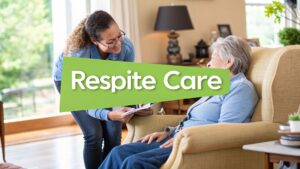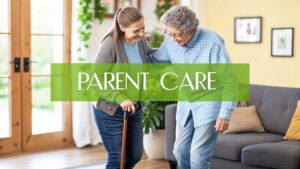When it comes to providing care at home, our goal is always to create a safe, supportive space where someone can live with dignity and comfort. This isn't just about ticking boxes on a checklist; it's about being proactive, managing risks, and tailoring a care plan that genuinely looks after the wellbeing of both the person receiving care and their carer.
Building the Foundations of Safe Home Care
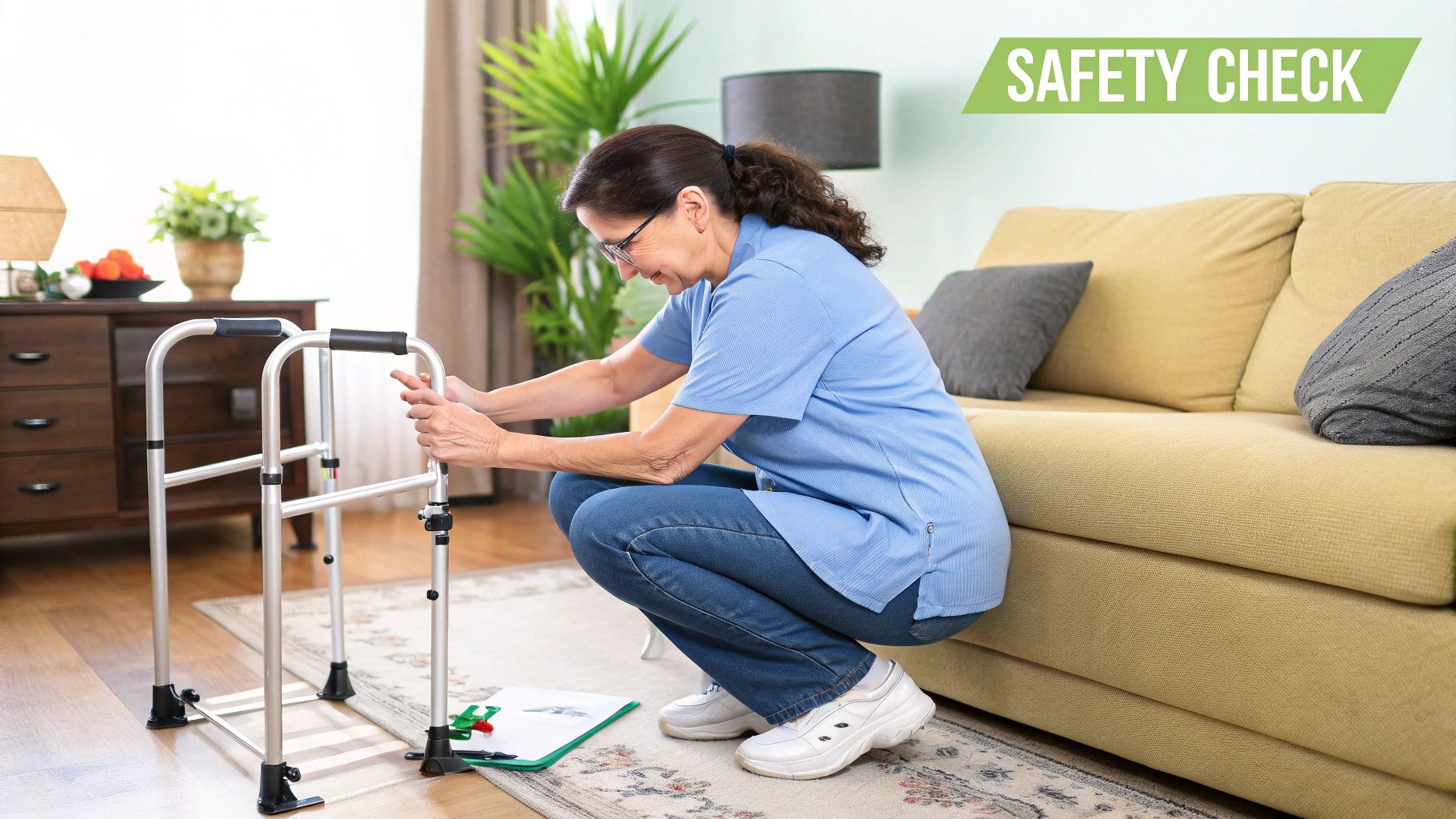
We often think of care in terms of compassion and kindness, which are absolutely essential. But underneath all of that, a strong health and safety framework is the real foundation. Think of it like building a house – without a solid, well-laid foundation, anything you build on top is going to be wobbly and unsafe.
This guide is designed to go beyond the usual jargon and give you a practical look at what it takes to keep people safe in their own homes. A private home isn't like a hospital; it's a unique setting with its own set of challenges, which makes getting the safety protocols right a top priority.
Why a Proactive Safety Culture Matters
Taking a proactive approach to safety has a massive impact on a person's quality of life and their ability to stay independent. It's all about looking ahead and anticipating what someone might need, rather than just waiting for something to go wrong.
This kind of forward-thinking helps in a few key ways:
- Preventing Accidents: It means spotting potential hazards—like a loose rug that could be a trip risk or a poorly lit hallway—before they lead to a fall.
- Promoting Dignity: It ensures that care is delivered respectfully, honouring an individual’s personal space and choices.
- Building Trust: When clients and their families know that safety is a priority, it creates a sense of confidence and peace of mind.
A big part of building a safe home environment is also understanding how to maintain a clean and healthy living space. For more on this, check out this excellent guide to healthy home cleaning.
A commitment to health and safety is more than just following rules. It’s a fundamental way of showing respect for a person, making it clear that their wellbeing is the absolute priority in everything we do.
From carrying out detailed risk assessments to having a solid plan for emergencies, every little piece contributes to a strong safety net. Ultimately, the quality of any https://creamhomecare.co.uk/home-care/ is measured by this deep-rooted commitment to keeping people safe.
Understanding Your Duty of Care in a Home Setting
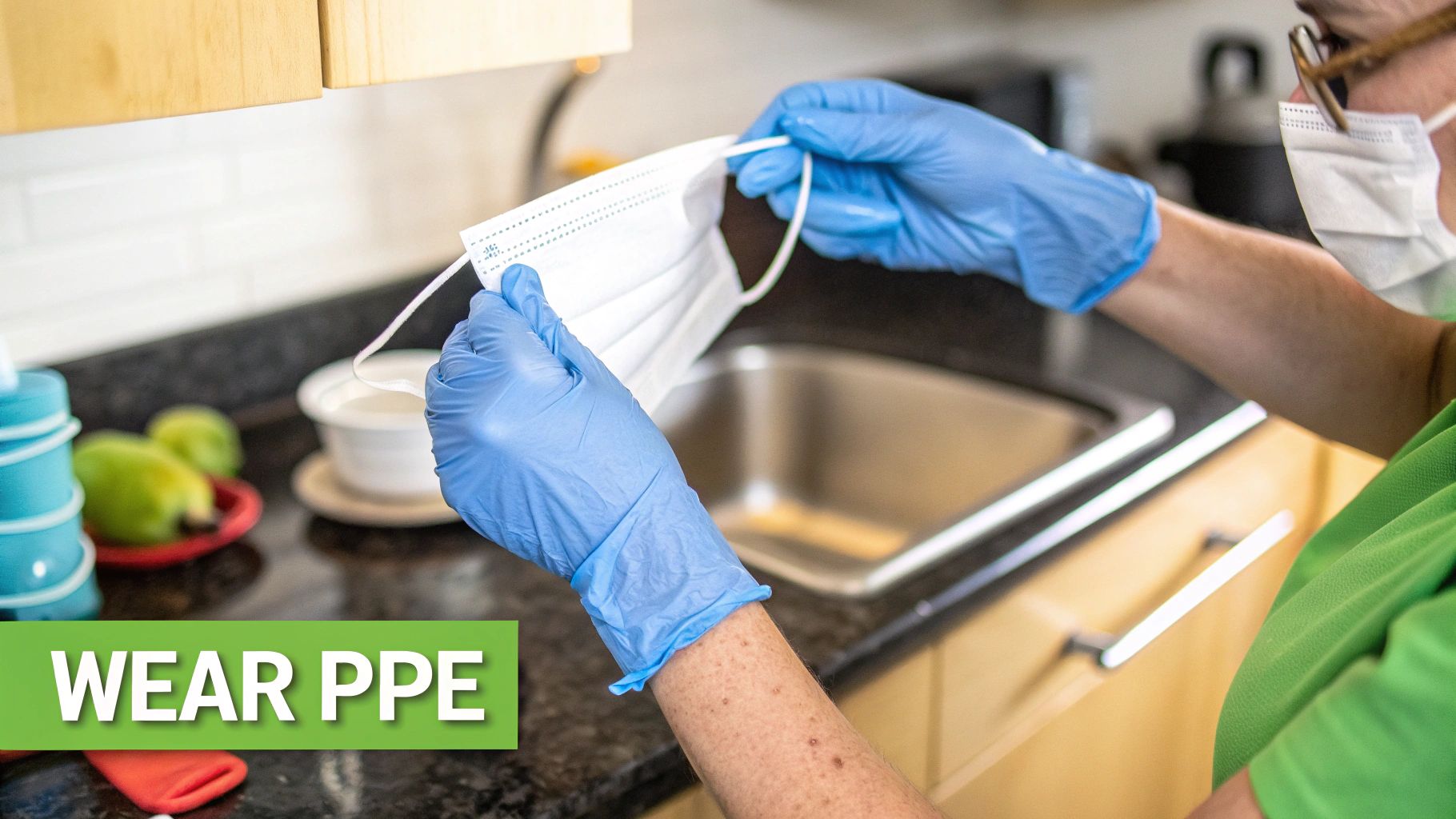
As a professional carer in the UK, you’re guided by a fundamental principle: a duty of care. This isn't just a suggestion to be careful; it’s your professional and ethical obligation to always act in the best interests of the person you support. It means you are responsible for protecting them from harm, whether through your actions or, just as importantly, your inaction.
When we talk about health and safety in home care, this duty becomes very practical. It's about taking sensible, proactive steps to keep your client safe from any predictable danger. You need to be observant and competent, especially in a home environment which, unlike a hospital, is full of unique and often unpredictable variables.
This responsibility isn’t just a matter of good practice—it's backed by law. The Health and Safety at Work etc. Act 1974 applies to everyone, from care agencies to individual carers. On top of that, the Care Quality Commission (CQC) holds all registered providers to strict standards, and safety is at the very core of every inspection they carry out.
Hazards and Risks: What's the Difference?
To really get your duty of care right, you first need to be crystal clear on two key terms: hazards and risks. People often mix them up, but in the world of health and safety, they have very distinct meanings. Nailing this distinction is the first step to properly assessing any situation.
-
A hazard is anything with the potential to cause harm. It’s the source of the danger. In a client's home, this could be a trailing electrical cable, a wet floor in the bathroom, or medication that’s been stored in the wrong place.
-
A risk is the likelihood of that hazard actually hurting someone, coupled with how serious that harm could be. Think of it as the probability of something going wrong.
Here's a simple way to look at it: that trailing cable (the hazard) poses a very high risk to a client who has trouble walking. But for a client who is bed-bound and never goes near that room, the risk is extremely low. Understanding this helps you focus on what really needs fixing first.
Duty of care transforms your role from simply performing tasks to actively safeguarding an individual's wellbeing. It means recognising that a simple observation, like noticing a frayed carpet edge, is a critical part of providing safe, person-centred support.
The Real-World Impact on Home Care
Putting these principles into practice is more important than ever. The UK's domiciliary care sector, valued at around £11.5 billion, is under immense pressure. It supports nearly 1 million people with publicly funded care, yet with our ageing population, demand is soaring. In fact, 48% of providers have reported being unable to meet current needs, often due to workforce shortages.
When resources are stretched thin, a sharp focus on health and safety is non-negotiable—it's what prevents accidents.
This is exactly why it's so vital to know the scope of your specific role. The safety measures you take will depend on whether you’re providing simple companionship or more complex support. Understanding the difference between personal care and home help is key to applying the right precautions for the tasks you're doing. Ultimately, your duty is to adapt your safety radar to the individual and their unique home.
Mastering the Home Care Risk Assessment
Let's get practical. Knowing about health and safety is one thing, but putting it into action is what truly makes a difference. This is where the risk assessment comes in. It’s not just another form to fill out; it's your way of systematically spotting and managing potential dangers in a client’s home.
Think of it as creating a bespoke safety map for every single person you care for. It turns vague ideas like ‘hazards’ and ‘risks’ into a clear, actionable plan. By working through it properly, you can get ahead of problems before they even happen, making things safer for your client and for you. Honestly, it's a non-negotiable skill for any professional carer.
The heart of any good risk assessment is a simple, logical flow.
As you can see, it all starts with spotting the dangers. From there, you figure out how serious they are, and finally, you put measures in place to keep everyone safe. It’s a straightforward approach that makes sure nothing important gets overlooked.
The Five Essential Steps of a Risk Assessment
To do a risk assessment that actually means something, follow this proven five-step process. This framework is the bedrock of good health and safety practice in home care because it ensures you cover all your bases, from that first look around to keeping things up to date.
-
Spot the Hazards: Start by having a proper look around the client's home. You're searching for anything that could cause harm. We’re talking about things like trailing wires, cluttered hallways, dimly lit stairs, or even a small pet that loves to get under your feet.
-
Identify Who Could Be Harmed and How: Next, think about everyone who could be affected. This obviously includes your client, but also visiting family, and you, the carer. For example, a wet bathroom floor is a huge fall risk for a client with poor mobility, but it’s also a danger for the carer who is helping them.
-
Evaluate the Risks and Decide on Precautions: Now, for each hazard you've spotted, you need to weigh things up. How likely is it to cause harm, and how bad could that harm be? A loose rug might seem minor, but for an older client, it represents a high risk of a serious fall. The fix could be as simple as using non-slip tape or just removing the rug entirely.
-
Record Your Findings and Implement Them: Writing it all down is crucial. Make a note of the hazards, the risks they create, and what you’ve done to control them. This record isn't just for compliance; it's vital for ensuring everyone on the care team is in the loop and it demonstrates you’re fulfilling your duty of care.
-
Review and Update as Necessary: A risk assessment is a living document, not a one-and-done task. It needs to be looked at regularly and especially updated when something significant changes. That could be a decline in the client's health, a new piece of equipment being introduced, or even just a furniture reshuffle.
A risk assessment isn’t about trying to create a completely risk-free world – that’s impossible. It's about making the environment as safe as is reasonably practical, so the client can live their life with confidence and dignity.
Bringing Risk Assessments to Life
Let's think about a couple of real-world examples.
Imagine you’re caring for a client who is becoming frail. During your assessment, you notice their kettle is heavy, and they struggle to lift it when it's full. That’s a serious scalding risk. Your control measure could be to find them a lightweight kettle or perhaps set them up with a hot water dispenser. Simple, but effective.
Another common scenario involves lone worker safety. If you're visiting a client late at night in an area with poor street lighting, your risk assessment needs to flag this. Your precautions might involve making sure you can park somewhere well-lit, having a strict check-in and check-out procedure with your agency, and carrying a personal safety alarm.
Every decision you make when organising care should be shaped by this proactive, safety-first mindset. To see how these preparations fit into the bigger picture of getting care started, have a look at our guide on arranging home care services in 5 simple steps.
Common Home Care Hazards and Practical Solutions
To help you get started, we've put together a table outlining some of the most common hazards you might encounter in a home care setting. This is by no means an exhaustive list, but it highlights the kind of thinking required to keep everyone safe.
| Hazard Category | Specific Example | Potential Risk | Mitigation Strategy |
|---|---|---|---|
| Slips, Trips & Falls | Loose rugs, trailing electrical cords, cluttered walkways. | Fractures, bruising, head injuries, loss of confidence. | Secure rugs with anti-slip backing, tidy cables away, ensure clear pathways. |
| Fire Safety | Faulty electrical appliances, unattended cooking, smoking. | Burns, smoke inhalation, property damage, fatality. | Regular appliance checks, install smoke alarms, create a fire escape plan. |
| Medication Management | Incorrect dosage, missed medication, confusing packaging. | Overdose, under-treatment, adverse drug reactions. | Use a pill organiser, set reminders, keep a clear medication chart (MAR). |
| Infection Control | Poor hand hygiene, improper disposal of waste. | Spread of infections (e.g., colds, flu, norovirus). | Implement strict handwashing protocols, use PPE, follow correct waste disposal. |
| Manual Handling | Lifting a client without proper technique or equipment. | Musculoskeletal injury to the carer, falls or injury to the client. | Use hoists/slide sheets where needed, receive proper training, assess the task first. |
| Environmental Hazards | Poor lighting, rooms that are too hot or too cold. | Falls due to poor visibility, dehydration, hypothermia. | Install brighter light bulbs, use fans or heaters, monitor room temperature. |
By thinking through these kinds of scenarios before they become problems, you transform the home from a place of potential hazards into a genuine sanctuary for your client. This proactive approach is the very essence of professional, compassionate care.
Practical Steps for Infection Prevention and Control
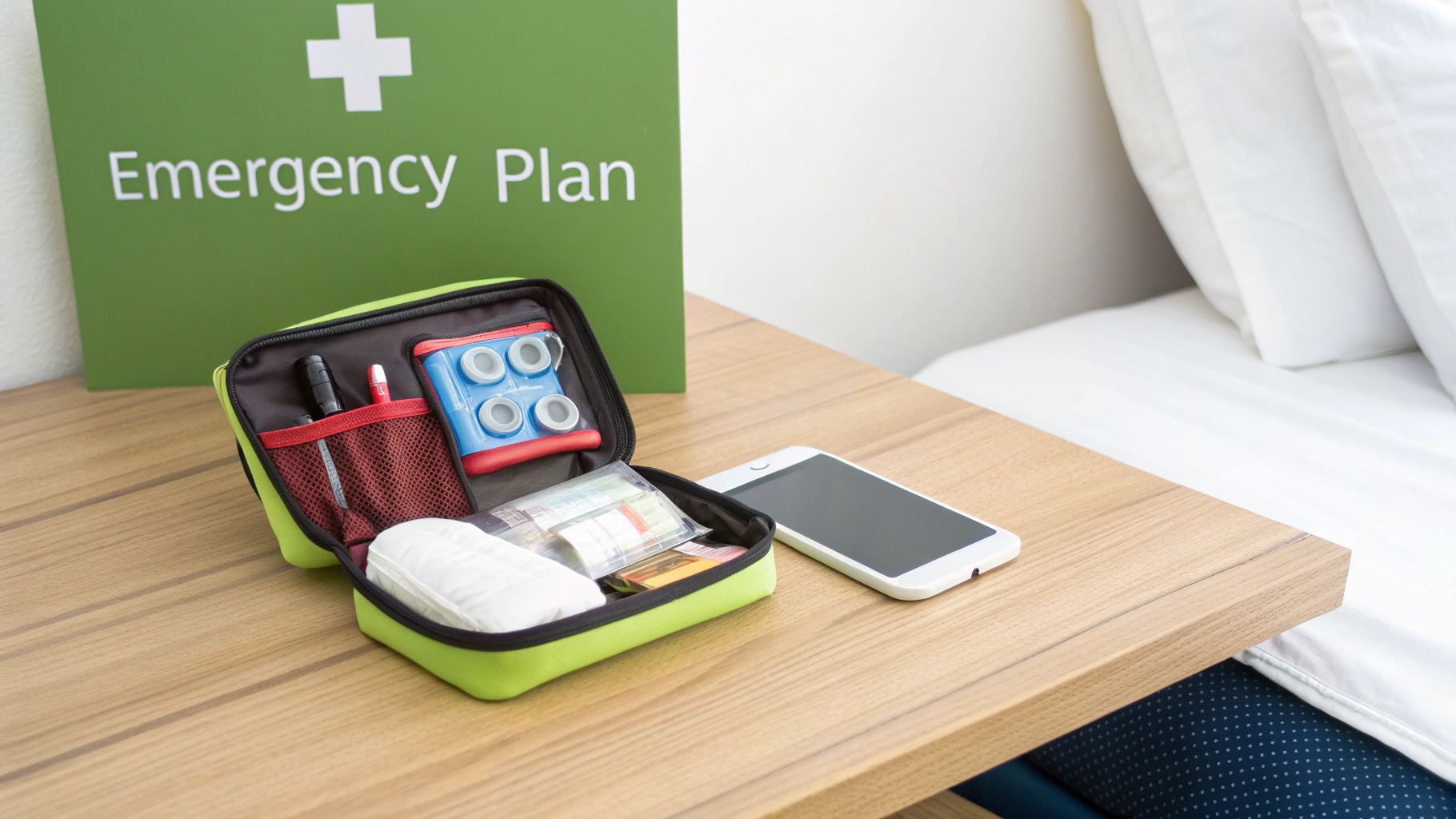
Keeping infections at bay is a huge part of providing top-notch health and safety home care. A client’s home isn't a sterile, clinical setting; it's a living space. That means you have to be extra vigilant, adapting professional standards to fit a domestic environment.
Success boils down to knowing how infections spread and, more importantly, how your actions can stop them in their tracks.
Think of it like breaking a chain. The "chain of infection" is simply the path a germ takes to get from a source to a person. Every single thing you do—from washing your hands to wiping down a worktop—is like taking out a link. Break the chain, and you prevent the illness.
The absolute cornerstone of all this is excellent hand hygiene. It’s your single most effective tool, and truly understanding the critical role of hand washing in infection prevention is non-negotiable for any professional carer.
Mastering the Fundamentals of Hygiene
Proper handwashing is so much more than a quick splash under the tap. To really get rid of germs, you need a thorough and consistent method. It’ll become second nature with practice, but it's vital before and after every client interaction, after dealing with waste, and before you even think about preparing food.
Here are the five key steps that make all the difference:
- Wet your hands with clean, running water.
- Lather up with enough soap to cover every surface.
- Scrub for a solid 20 seconds. Don't forget the backs of your hands, in between your fingers, and under your nails.
- Rinse everything off thoroughly under clean, running water.
- Dry your hands completely with a clean towel or let them air dry.
Stick to these steps every single time. This is your first line of defence.
Correct Use of Personal Protective Equipment
Personal Protective Equipment (PPE) is your second shield. You'll need it whenever there’s a risk of coming into contact with bodily fluids. In home care, this usually means disposable gloves and aprons.
Using PPE correctly isn’t just about putting it on. It’s about knowing when to use it and how to get rid of it safely to avoid cross-contamination. This discipline is what separates good practice from genuinely professional care.
Always put on a fresh pair of gloves and an apron for tasks like personal hygiene assistance, handling soiled laundry, or cleaning up spills. The crucial part is to remove and dispose of them the moment you're done, then immediately wash your hands. Never, ever wear the same pair of gloves from one task to the next.
The need for these strict health and safety habits is clear when you look at the sheer scale of care in England. Around 586,000 people receive a local authority social care assessment each year. The sector's ability to manage infection control is vital. Even with care homes nearly full, the system showed its strength by keeping up to 99.6% of homes open for visits during the pandemic by following these kinds of robust safety measures.
Safe Handling of Laundry and Waste
Beyond personal hygiene, you have to manage the client's environment. Always handle soiled laundry carefully while wearing gloves and an apron. It should be washed separately from other items and at the hottest temperature the fabric can safely handle to kill any lingering germs.
The same goes for clinical waste like used continence pads or old wound dressings. They need to be disposed of correctly. Double-bag this waste securely and make sure you're following the local authority’s specific rules for collection. It’s a simple step that prevents contamination and helps keep refuse workers safe.
By consistently applying these practical steps, you create a far safer and healthier environment for your client and for yourself.
Getting Medication and Manual Handling Right
When it comes to hands-on care, two areas carry the highest risk: helping people move and managing their medication. There's no room for error here. Getting these tasks right is fundamental to a client's wellbeing and preventing serious harm.
It’s not just about protecting the person you’re supporting, either. Using the correct techniques protects your own physical health, meaning you can continue to provide great care without putting your back, or your career, at risk. This is where mastering health and safety in home care really shows. It's about ditching old, risky habits for proven, safe procedures—swapping brute force for smart technique in manual handling, and being absolutely meticulous when it comes to medication.
The Truth About Safe Manual Handling
Any time you lift, move, or support a person, you're performing a manual handle. It's a huge part of the job, and if you do it wrong, it's one of the fastest ways to injure yourself. Painful back problems are incredibly common among carers, but they don't have to be.
The core principle is simple: avoid hazardous lifting whenever you possibly can. And when you can't avoid it, you must use the right equipment and the right techniques.
Think of your body like a lever. You need a solid, stable base to work from. That means planting your feet wide, keeping your back straight, and bending at your knees. You should be using the power in your legs to lift, not straining your back. Twisting your spine while lifting is a definite no-go—it’s a recipe for disaster.
Lots of people think manual handling is all about strength. It’s not. Safe and effective moving and handling is a skill. It’s about planning, using the right technique, and knowing when to use equipment. It’s about working smarter, not harder.
It's also crucial to leave outdated and dangerous methods in the past. Techniques like the 'drag lift' or lifting someone from under their arms are no longer considered safe practice. They put a huge strain on your back and can easily dislocate a client's shoulder.
Using Equipment the Right Way
Thankfully, modern equipment has made manual handling so much safer. Things like hoists and slide sheets are designed to take the strain, but they're only helpful if you know what you're doing.
- Hoists: Before you even think about using a hoist, check the LOLER sticker to make sure it’s been serviced recently. Make sure the sling is the right type and size for the client and that it's in good nick, with no rips or tears.
- Slide Sheets: These are fantastic for repositioning someone in bed with minimal effort. The trick is to use smooth, controlled movements. If the care plan says two people are needed, don't try to be a hero and do it alone.
And the golden rule? Never, ever use a piece of equipment you haven't been properly trained on. The risk assessment should always spell out what aids are needed, and the care plan will tell you exactly how and when to use them.
The Six Rights of Medication Management
Medication is another area where precision is everything. A tiny mistake can have massive consequences. To stay safe, we follow a simple but powerful checklist known as the 'Six Rights' (or 'Six Rs') of medication management. Think of it as your final safety check before you assist with any medicine.
Committing these six points to memory is absolutely essential.
- Right Person: Are you 100% sure you’re with the correct individual? Check.
- Right Medicine: Does the medication in your hand match the MAR chart or prescription exactly? Double-check.
- Right Dose: Is the amount precisely what has been prescribed?
- Right Route: How should it be taken? Orally, topically, or another way?
- Right Time: Is it the correct time for this dose, according to the care plan?
- Right to Refuse: Does the person have the capacity to and want to take the medication?
- Right Documentation: As soon as it's taken, record it accurately.
Beyond this checklist, safe practice means storing medication securely—usually in a locked box—and keeping clear, up-to-date records. And if a mistake does happen, you must report it to your manager or agency immediately. Honesty and transparency are the only ways we can learn and prevent it from happening again.
How to Prepare for Emergencies in the Home
When you're a home carer, your ability to stay calm and think clearly during an emergency can genuinely change the outcome. Having a solid plan isn't about being pessimistic; it’s about being professional and ready for anything, whether that’s a sudden medical issue like a fall or a crisis like a fire.
A well-rehearsed emergency plan is the bedrock of professional health and safety in home care. It allows you to move past the initial shock and act with confidence, making sure the person you're supporting gets the right help, right away. This isn't just good practice—it's a fundamental part of your duty of care.
Planning for Different Scenarios
Emergencies don't come in a one-size-fits-all package, so your response plan can't be either. What you do for a medical emergency is completely different from how you'd handle a sudden power cut. The trick is to have simple, clear action plans for the most likely situations.
-
Medical Emergencies: For a fall, a suspected stroke, or a bad allergic reaction, your first and most important action is to call 999. While waiting, keep the person as calm and comfortable as you can, but don't move them if there’s any chance of a head or spinal injury. Make sure you have their medical history and a list of their current medications ready to hand over to the paramedics.
-
Environmental Crises: If the power goes out, you need to know exactly where to find torches and a battery-powered radio. But for a fire, the goal is totally different and much more urgent: get everyone out of the building. That's it.
The Importance of Fire Safety and Evacuation Plans
Fire safety needs its own special focus because the stakes are incredibly high. Tragically, fires are the leading cause of injury-related deaths for older adults at home, which makes having a clear escape plan an absolute necessity. You must know at least two ways out of the property and ensure those routes are always free of clutter.
This is where a Personal Emergency Evacuation Plan (PEEP) comes in. This isn't a generic fire drill poster; it's a plan built entirely around your client's individual needs. A PEEP takes their mobility, cognitive state, and any hearing or sight impairments into account to create a realistic evacuation strategy that will actually work for them.
A PEEP transforms fire safety from an abstract idea into a practical, life-saving procedure. It means that in the middle of a crisis, a person’s specific challenges have already been considered, allowing for a fast and dignified evacuation.
Recent updates to fire safety regulations in the UK care sector have reinforced just how crucial these proactive steps are. The focus is on better protecting vulnerable people, making PEEPs an essential part of safety protocols. To learn more about these changes, you can discover more insights about fire safety in UK care homes from Brabners.
Creating an Emergency Grab Bag
To make responding even faster, it's a great idea to put together a simple 'grab bag'. Think of it as your emergency toolkit—a small, accessible bag holding all the vital information you'd need in a rush. It takes the pressure off trying to remember crucial details when things get hectic.
Your grab bag should contain:
- A list of emergency contacts (family, GP, care agency).
- A copy of the client’s up-to-date medication list and medical history.
- Details of any known allergies.
- A copy of their PEEP.
- A small first-aid kit.
Keep this bag somewhere obvious where any carer can find it easily, like next to the front door or in the main living space. Having this information ready to go means you can give emergency services clear, accurate details and ensure nothing important gets missed.
Your Home Care Safety Questions Answered
Putting safety principles into practice often brings up a lot of questions. Let’s walk through some of the most common queries we hear from carers, clients, and their families to give you a clearer picture of how safety works in real-life home care situations.
Think of this as a practical troubleshooting guide to help you feel more confident when you're on the ground.
What Is My Responsibility If a Client Refuses a Safety Recommendation?
This is a tricky one, and it's all about balancing safety with a person's right to make their own choices. If a client refuses something you’ve recommended—say, moving a rug that's a clear trip hazard—your first step is to calmly explain the risks without being pushy.
The crucial next step is to document everything. Make a clear note of the conversation and the client's refusal in their care plan. You must then report the situation to your manager or care agency immediately. They have the responsibility to formally assess the client's capacity to make that decision and can work with the family to find a compromise that respects the client's wishes while still keeping them as safe as possible.
How Often Should Carers Receive Health and Safety Training?
In the UK, there isn't a strict legal timetable, but the gold standard in the care industry is annual refresher training. This covers the big four: manual handling, infection control, basic life support, and fire safety.
Consistent, up-to-date training isn't just a box-ticking exercise. It's the professional backbone that keeps a carer’s skills sharp and ensures their day-to-day practices meet the latest safety standards. Ultimately, it means safer, higher-quality care for the client.
It’s also important to remember that training isn't just a once-a-year thing. If there are big changes—like new legislation, updated CQC guidance, or a shift in a client’s needs that brings new risks—your training needs to be updated to match.
Who Is Responsible for Providing PPE in Home Care?
The law in the UK is very clear on this: it is always the employer’s responsibility. Your home care agency is legally required to provide all the Personal Protective Equipment (PPE) you need to do your job safely, completely free of charge.
This includes essentials like disposable gloves, aprons, and masks, plus anything else your risk assessment shows is necessary. The agency must also train you on how to use, store, and dispose of it all correctly to prevent infection. You should never be in a position where you're asked to buy your own PPE.
At Cream Home Care, we believe that outstanding care is built on a foundation of exceptional safety standards. Our professional team is trained to manage risks proactively, ensuring your loved one can live with confidence and dignity in their own home. To find out more about our compassionate and secure care services in Stoke-on-Trent and Newcastle-under-Lyme, please visit our official Cream Home Care website.



